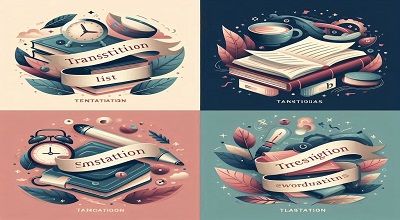categories of transitional words
Transitional words and phrases are essential in academic papers to help readers follow the flow of ideas and understand the relationships between different parts of the text. There are several categories of transitional words that you can use in your academic papers. Here are four main categories:
Addition Transitions:
- Additionally
- Moreover
- Furthermore
- In addition
- Also
- Besides
- Not only… but also
- Likewise
Example: Moreover, the study’s findings suggest a significant correlation between the variables.
Contrast Transitions
- However
- Nevertheless
- On the contrary
- Conversely
- Although
- On the other hand
- In contrast
- Despite
Example: Despite the initial assumptions, the experimental results did not support the expected outcome.
Sequence/Order Transitions
- First, second, third
- Next
- Then
- Meanwhile
- Afterward
- Subsequently
- Finally
- In conclusion
Example: Firstly, the literature review provides a comprehensive overview of existing research. Next, the methodology section outlines the research design and data collection process.
Cause and Effect Transitions
- Therefore
- Consequently
- Thus
- As a result
- Because
- Since
- Hence
- Owing to
Example: The changes in environmental policies have, consequently, led to a reduction in carbon emissions.
It’s important to use transitional words judiciously and consider the context in which you’re using them. Additionally, make sure that your use of transitional words aligns with the logical flow of your ideas within the paper.
Transitional words and phrases play a crucial role in academic writing by helping to establish connections between ideas, improve coherence, and guide the reader through the logical flow of the text. These words serve as bridges between sentences, paragraphs, and sections, contributing to a more organized and understandable piece of writing. In academic papers, the effective use of transitional words is essential for conveying complex arguments and maintaining the overall coherence of the content. Here, we will explore four main categories of transitional words commonly employed in academic writing.
Addition Transitions
One fundamental category of transitional words involves expressing the addition of ideas. These words help to introduce new information, elaborate on existing points, or provide examples that support the main argument. Examples of addition transitions include “furthermore,” “moreover,” “in addition,” and “additionally.” These words are instrumental in expanding on the thesis or supporting evidence, creating a sense of progression and completeness in the paper.
Example: Furthermore, recent research has shown a significant correlation between regular exercise and improved cognitive function in adults.
Contrast Transitions
Another critical set of transitional words deals with expressing contrast or opposition between ideas. These words help to highlight differences, present alternative viewpoints, or introduce conflicting evidence. Examples of contrast transitions include “however,” “nevertheless,” “on the contrary,” and “although.” By using these words, writers can guide readers through nuanced arguments and demonstrate a sophisticated understanding of the subject matter.
Example: Although some studies suggest a positive relationship between social media use and mental health, other research, nevertheless, presents compelling evidence of adverse effects, particularly in adolescents.
Sequence Transitions
Sequence transitions are essential for organizing ideas chronologically or logically. They help readers follow the order of events, steps in a process, or the development of an argument. Examples of sequence transitions include “firstly,” “next,” “then,” and “finally.” These words provide a roadmap for the reader, making it easier to comprehend the structure of the paper and the progression of ideas.
Example: First, we will examine the historical context of the conflict, next, we will analyze its economic implications, and finally, we will explore potential solutions.
Cause and Effect Transitions
Cause and effect transitions elucidate the relationship between different aspects of the topic by indicating reasons or consequences. These transitions help establish a logical connection between ideas, demonstrating the impact of one phenomenon on another. Examples of cause and effect transitions include “because,” “due to,” “consequently,” and “therefore.” Effective use of these words enhances the paper’s coherence by clarifying the causal relationships within the content.
Example: Due to the increased global temperatures, there has been a noticeable rise in the frequency and intensity of extreme weather events; consequently, climate change adaptation strategies have become imperative.
Final Conclusion
In conclusion, mastering the use of transitional words is a key skill for academic writers. These words not only enhance the overall coherence of the paper but also contribute to a s smoother reading experience. By incorporating addition, contrast, sequence, and cause-and-effect transitions, writers can guide their readers through complex arguments, making the content more accessible and engaging. As a result, academic papers become more persuasive and effectively convey the intended message to the audience.
